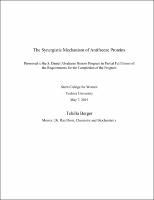Please use this identifier to cite or link to this item:
https://hdl.handle.net/20.500.12202/8887| Title: | The synergistic mechanism of antifreeze proteins |
| Authors: | Drori, Ron Berger, Tehilla |
| Keywords: | Synergistic Mechanism antifreeze proteins glycoproteins isoforms Antifreeze proteins and glycoproteins (AF(G)Ps) |
| Issue Date: | 9-May-2019 |
| Publisher: | Yeshiva University |
| Citation: | Berger, T. (2019, May 9). The synergistic mechanism of antifreeze proteins [Undergraduate honors thesis, Yeshiva University]. |
| Series/Report no.: | S. Daniel Abraham Honors Program;May 9, 2019 |
| Abstract: | Antifreeze proteins and glycoproteins (AF(G)Ps) help cold-adapted organisms, such as fish, plants, and insects, to endure the subfreezing climates they preside in. These proteins bind to the surfaces of small ice crystals preventing further ice growth. Fish and insects use multiple AF(G)P isoforms, which vary greatly in their ability to inhibit ice. In some fish, the passive isoform that barely inhibits ice growth is more abundant than the active isoform. A synergistic enhancement of AF(G)Ps activity by mixture of two isoforms was revealed more than 40 years ago regarding AFGP (Osuga 1978) and AFPIIII (Takamichi 2009), but the mechanism that explains this phenomenon is still obscure. Using cold-stages, microfluidics, and fluorescence microscopy, we tested the activity of binary mixtures of AFPs from a fish and a plant. AFPIII and AFGP both exist in active and passive isoforms, and thus their passive isoforms were mixed with every active AF(G)P. Synergistic, additive, and antagonistic effects of the proteins’ activity were observed for various binary mixtures. The passive protein AFPIII-SP showed synergy in all mixtures, with the exception of with AFPI, with which it showed additive activity. Passive AFGP7-8 only showed synergy when mixed with the active AFGP, as well as with the passive form of AFPIII. However, when mixed with AFPI and LpAFP, proteins with more moderate activity, antagonistic effects were observed. When the two active isoforms of AFGP and AFPIII were mixed, the results were antagonistic. Ice crystals that grew in microfluidic channels with a binary mixture of AFPIII isoforms tagged with different fluorescence dyes exhibited complementary binding to the prism and pyramidal planes of the crystal. Synergy was observed regardless of the AF(G)Ps’ structure, suggesting that specific protein-protein interactions are not driving the activity enhancement or reduction. Synergistic enhancement was obtained in mixtures that included an active isoform, which binds rapidly to 3 the prism plane, and a slower passive isoform that binds to a pyramidal plane. The active isoform binds first to the prism plane, slows down growth and creates pyramidal surfaces, to which the passive isoform binds. This series of events leads to synergistically enhanced ice growth inhibition. In contrast, the AF(G)Ps that were antagonistic bind to the same ice-crystal plane, suggesting competition on the similar binding site. These results explain the mechanism of synergy between AF(G)P isoforms in binary mixtures, which is driven by complementary binding and a combination of rapid and slower adsorption rates to ice. These results are important to the AFP field as they identify a process that seems to exist in all AF(G)P-containing fish. While previous studies have highlighted the existence of synergy in isolated contexts, such as that of either AFPIII or AFGP (Osuga 1979, Zepeda 2008, Takamichi 2009), there has yet to be a conclusive and comprehensive statement regarding the mechanism of synergy in all fish. A cross-species synergy mechanism will be an exciting revelation in the field of AFPs and may explain other protein cooperative interactions. Discoveries in the field of antifreeze proteins not only further our understanding of how fish resist freezing of their bodily fluids, but have applications in preservation techniques, medicinal procedures, and technological advances. Antifreeze proteins have already been introduced as a proposed mechanism to preserve organs (Wang 1994) as well as for vitrification (Wowk 2000), and have been implemented in various food products (Boonsupthip 2003). AF(G)Ps thus influence a diverse range of specialties in a significant way. |
| Description: | Honors thesis / Open Access |
| URI: | https://hdl.handle.net/20.500.12202/8887 |
| Appears in Collections: | S. Daniel Abraham Honors Student Theses |
Files in This Item:
| File | Description | Size | Format | |
|---|---|---|---|---|
| Tehilla Berger Honors Thesis Final- May 2019.pdf | 964.94 kB | Adobe PDF |  View/Open |
This item is licensed under a Creative Commons License

